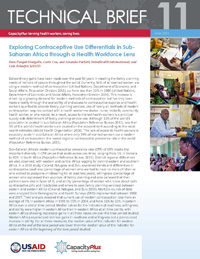June 2013
Sara Pacqué-Margolis, Carie Cox, and Amanda Puckett, IntraHealth International; and Lois Schaefer, USAID
 Extraordinary gains have been made over the past 50 years in meeting the family planning needs of millions of people throughout the world. Currently, 56% of all married women are using a modern method of contraception (United Nations 2011), up from less than 10% in 1960 (United Nations 2004). This increase is driven by a growing demand for modern methods of contraception but has only been made a reality through the availability of and access to contraceptive supplies and health workers qualified to provide family planning services. Use of nearly all methods of modern contraception requires contact with a health worker—a doctor, nurse, midwife, community health worker, or pharmacist. As a result, access to trained health workers is a principal supply-side determinant of family planning service use. Although 13% of the world’s population is located in sub-Saharan Africa (Population Reference Bureau 2011), less than 3% of the world’s health workers are located on the subcontinent according to the most recent estimates (World Health Organization 2006). This lack of access to health workers is especially acute in sub-Saharan Africa where only 19% of married women use a modern method of contraception, the lowest regional contraceptive prevalence rate in the world (Population Reference Bureau 2011).
Extraordinary gains have been made over the past 50 years in meeting the family planning needs of millions of people throughout the world. Currently, 56% of all married women are using a modern method of contraception (United Nations 2011), up from less than 10% in 1960 (United Nations 2004). This increase is driven by a growing demand for modern methods of contraception but has only been made a reality through the availability of and access to contraceptive supplies and health workers qualified to provide family planning services. Use of nearly all methods of modern contraception requires contact with a health worker—a doctor, nurse, midwife, community health worker, or pharmacist. As a result, access to trained health workers is a principal supply-side determinant of family planning service use. Although 13% of the world’s population is located in sub-Saharan Africa (Population Reference Bureau 2011), less than 3% of the world’s health workers are located on the subcontinent according to the most recent estimates (World Health Organization 2006). This lack of access to health workers is especially acute in sub-Saharan Africa where only 19% of married women use a modern method of contraception, the lowest regional contraceptive prevalence rate in the world (Population Reference Bureau 2011).
Sub-Saharan Africa’s modern contraceptive prevalence rate (CPR) of 19% masks the important diversity in CPR values that exists across countries, ranging from 1% in Somalia to 60% in South Africa (Population Reference Bureau 2011). Distinct regional differences are also observed, with western and central Africa lagging far behind eastern and southern Africa. In a 2010 study, Cleland, Ndugwa, and Zulu examined trends and differentials in contraceptive readiness (percentage of women who wanted to have no more children or who wished to postpone childbearing for at least two years), willingness (percentage of women who expressed their approval of family planning and who believed that their partners were also in favor of it), and ability (percentage of women who knew about both contraceptive pills and injectables and where to seek family planning services) between eastern and western Africa (Cleland, Ndugwa, and Zulu 2011). Multiple rounds of data were analyzed from Demographic and Health Surveys (DHS) implemented between 1988 and 2007. Their analysis revealed that current use of modern contraception rose from an average of 7% in western Africa in 1991 to 15% in 2004, and from 16% to 33% in eastern Africa over a similar time period. Median values for the indicators of readiness, willingness, and ability were higher in eastern Africa than in western Africa at all time points, with eastern Africa showing impressive gains in all three measures over the time period studied. Western Africa experienced minimal gains in readiness and willingness but a pronounced increase in ability. For all three measures, the median value of the indicator for western Africa at the end of the time period was lower than the median value of the indicator for eastern Africa at the beginning of the time period studied.
Next >>
A printer-friendly version is available.